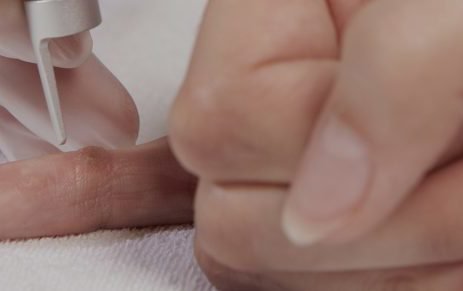Seborrhoeic Keratoses
Seborrhoeic keratoses, also known as basal cell papillomas or seborrhoeic warts, are common growths on the skin that look like large moles.
While usually harmless, some people opt to have them removed – get in touch today to see how the team at The Dermatology Clinic can help.

It’s always wise to get any unusual skin changes, or changes in the appearance of moles, checked by a specialist. Find more information below on seborrhoeic keratoses, and treatments available at The Dermatology Clinic London.
About seborrhoeic keratoses
Seborrhoeic keratoses are benign growths caused by a build-up of ordinary skin cells. They do not become malignant and are not infectious.
This skin condition affects more than a third of women and more than half of men in the UK. They are not hereditary, but a tendency to develop larger numbers of seborrhoeic keratoses can run in families. There is some suggestion that seborrhoeic keratoses are caused by sun exposure.
Anyone can be affected by seborrhoeic keratoses, but if you have darker skin they can appear as multiple small black or dark brown bumps, particularly on the neck or face. In this case it is referred to as dermatosis papulosa nigra.
What do seborrhoeic keratoses look like?
Seborrhoeic keratoses range from pale brown through black in colour and have a rough surface.
Over time, seborrhoeic keratoses that first appeared small and flat can become larger and more raised. The size of the growths varies from smaller than one centimetre to several centimetres across. Seborrhoeic keratoses most commonly occur on the torso, but they can also appear on the neck and head. They usually look as though they are ‘stuck on’ to the skin’s surface.
Although they are far more common than skin cancers, seborrhoeic keratoses that are very dark in colour can resemble a melanoma. In this case it’s important to visit The Dermatology Clinic to get an accurate diagnosis from one of our experienced consultants.
“ Skin cancer rates have been steadily on the rise over the past 30 years, it’s essential for people to check their skin regularly, making it a part of their routine. Early detection saves lives. ”
Treating seborrhoeic keratoses
Although seborrhoeic keratoses are harmless, many people choose to have them removed at The Dermatology Clinic. Reasons for this include:
- Seborrhoeic keratoses can be itchy or become inflamed
- Depending on their location, they can catch on clothing
- The appearance of seborrhoeic keratoses can cause distress if they occur in a noticeable area such as the face
Are your seborrhoeic keratoses becoming a nuisance? Do you feel self-conscious because of the appearance of seborrhoeic keratoses on your skin? No matter what your reason, our expert dermatologists are available to help you. Our excellent treatment options include:
In this instance, one of our trained dermatologists will freeze off the seborrhoeic keratoses using liquid nitrogen.
Using a small, spoon-like instrument, we can gently remove the growth under local anaesthetic.
Both of these interventions to remove a seborrhoeic keratosis can leave a mark on the skin. This is because despite being highly effective, these treatments can sometimes cause scarring or altered pigmentation.
If you have any concern about a skin lesion, The Dermatology Clinic team are here to help you. We will guide you through each treatment option so you can make an informed choice.




